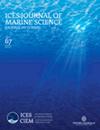Seasonal shift in energy allocation from somatic growth to lipid storage and the link between pre-winter condition and overwintering potential in juvenile Pacific cod
IF 3.4
2区 农林科学
Q1 FISHERIES
引用次数: 0
Abstract
Warming temperatures in the Gulf of Alaska have been linked to recruitment failure in Pacific cod (Gadus macrocephalus), but the mechanisms and timing of mortality events for juveniles are unclear. To date, limited research has focused on overwintering success, and the knowledge of juvenile ecology and physiology is based entirely on summer observations. Here, we investigate the changes in body condition, diet composition, and tissue-specific fatty acid (FA) storage for age-0 Pacific cod in Kodiak, Alaska, from February to December during 2018 and 2020. We observed protracted nearshore residency from June to December. Cod body condition (Kdry) and predicted weight at length were lowest in October, November, and December. Although not different interannually, diet composition varied seasonally, which corresponded to an increase in cod length. A range of condition metrics (HSIwet, FA concentration in liver tissue, and the % of whole body FAs stored in the liver) began to increase in September. Cod prioritized growth during the summer, while in the autumn and pre-winter they allocated more energy into lipid storage. We conclude that seasonal changes in tissue-specific FA storage and pre-winter fish conditions are important factors to consider for understanding overwintering potential of juvenile Pacific cod.太平洋鳕鱼幼鱼从体细胞生长到脂质储存的能量分配季节性变化以及冬前状况与越冬潜力之间的联系
阿拉斯加湾的气温升高与太平洋鳕鱼(Gadus macrocephalus)的繁殖失败有关,但幼鱼死亡事件的机制和时间尚不清楚。迄今为止,有关越冬成功率的研究十分有限,有关幼鱼生态学和生理学的知识完全基于夏季观察。在此,我们调查了 2018 年和 2020 年 2 月至 12 月期间阿拉斯加科迪亚克 0 龄太平洋鳕鱼的身体状况、食物组成和组织特异性脂肪酸(FA)储存的变化。我们观察到,鳕鱼在 6 月至 12 月期间长期在近岸栖息。鳕鱼的身体状况(Kdry)和预测体重在 10 月、11 月和 12 月最低。尽管年际间没有差异,但食物组成随季节变化,这与鳕鱼体长的增加相对应。从 9 月份开始,一系列条件指标(HSIwet、肝脏组织中的 FA 浓度和肝脏中储存的全身 FA 百分比)开始增加。鳕鱼在夏季优先生长,而在秋季和冬季前则将更多能量用于脂质储存。我们的结论是,组织特异性脂肪酸储存的季节性变化和冬前鱼类状况是了解太平洋鳕鱼幼鱼越冬潜力的重要因素。
本文章由计算机程序翻译,如有差异,请以英文原文为准。
求助全文
约1分钟内获得全文
求助全文
来源期刊

ICES Journal of Marine Science
农林科学-海洋学
CiteScore
6.60
自引率
12.10%
发文量
207
审稿时长
6-16 weeks
期刊介绍:
The ICES Journal of Marine Science publishes original articles, opinion essays (“Food for Thought”), visions for the future (“Quo Vadimus”), and critical reviews that contribute to our scientific understanding of marine systems and the impact of human activities on them. The Journal also serves as a foundation for scientific advice across the broad spectrum of management and conservation issues related to the marine environment. Oceanography (e.g. productivity-determining processes), marine habitats, living resources, and related topics constitute the key elements of papers considered for publication. This includes economic, social, and public administration studies to the extent that they are directly related to management of the seas and are of general interest to marine scientists. Integrated studies that bridge gaps between traditional disciplines are particularly welcome.
 求助内容:
求助内容: 应助结果提醒方式:
应助结果提醒方式:


